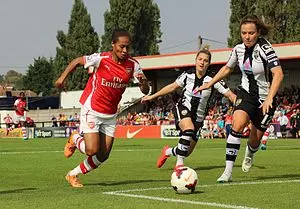 Arsenal's Ellen White (L) and Steph Houghton (R) with the WSL trophy
Arsenal's Ellen White (L) and Steph Houghton (R) with the WSL trophy
The Women's Super League (WSL), also known as the Barclays Women's Super League (BWSL), has taken the world of women's football by storm. Established in 2010, this league has become the pinnacle of women's football in England, captivating fans with its thrilling matches and talented players. With the backing of the Football Association and twelve fully professional teams, the WSL has brought a new level of excitement and competitiveness to the sport.
A Revolutionary League
The WSL was created to replace the FA Women's Premier League National Division as the highest level of women's football in England. In its inaugural season in 2011, eight teams competed for the title. Since then, the league has grown in popularity and stature, attracting more teams and expanding its reach. In the 2023-24 season, twelve teams are vying for glory in the Women's Super League.
 Arsenal v Notts County in 2014
Arsenal v Notts County in 2014
Evolution of the League
The Women's Super League has undergone significant changes since its inception. Initially played during the summer months from March to October, the league transitioned to a winter season running from September to May in 2017-18. This change aligned the league with the traditional football calendar in England.
From 2014 to 2017-18, the WSL consisted of two divisions - FA WSL 1 and FA WSL 2 - enabling promotion and relegation. In 2018-19, the second division was rebranded as the FA Women's Championship, solidifying the league structure. The WSL champions, runners-up, and third-placed team qualify for the UEFA Women's Champions League, adding further prestige to the competition.
Dominant Forces and Top Scorers
Chelsea has emerged as the dominant force in the Women's Super League, winning the title six times, including the 2022-23 season. Arsenal closely follows with three titles, while Liverpool and Manchester City have also tasted success. Chelsea's Sam Kerr and Vivianne Miedema of Arsenal have been among the top goalscorers, showcasing their extraordinary talent on the field.
Players Making History
The Women's Super League has witnessed some exceptional players who have etched their names in history. Sophie Ingle holds the record for the most appearances in the league, amassing an impressive 187 appearances. Other notable players include the likes of Steph Houghton, Jordan Nobbs, and Beth Mead, who have made significant contributions to their respective teams.
 Arsenal's Ellen White (L) and Steph Houghton (R) with the WSL trophy
Arsenal's Ellen White (L) and Steph Houghton (R) with the WSL trophy
Financial Support and Broadcast Reach
The Women's Super League has seen a surge in financial support and sponsorship. In 2019, a groundbreaking sponsorship deal was struck with Barclays, providing a significant boost to the league's profile and prize money. This partnership marked a turning point, highlighting the investment and growth potential of women's football in the UK.
Broadcasting of WSL matches has also received substantial attention. In the UK and Ireland, matches are televised on Sky Sports and the BBC, with select games reaching an international audience. The league's popularity has extended to countries such as Australia, Canada, Germany, Italy, and the United States, allowing fans from around the world to witness the excitement firsthand.
Join the Revolution
The Women's Super League has revolutionized women's football in England, providing a platform for talented players to showcase their skills and passion for the game. With its thrilling matches, dedicated teams, and loyal fanbase, the WSL is cementing its place as a premier women's football league globally. Don't miss out on the action—join the revolution and support your favorite team in the Women's Super League!
Note: All information in this article is accurate as of the 2023-24 Women's Super League season.
















